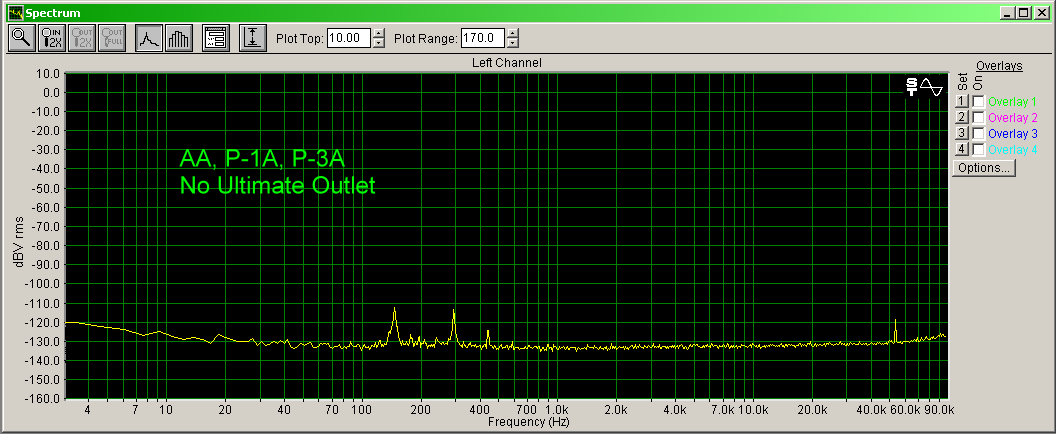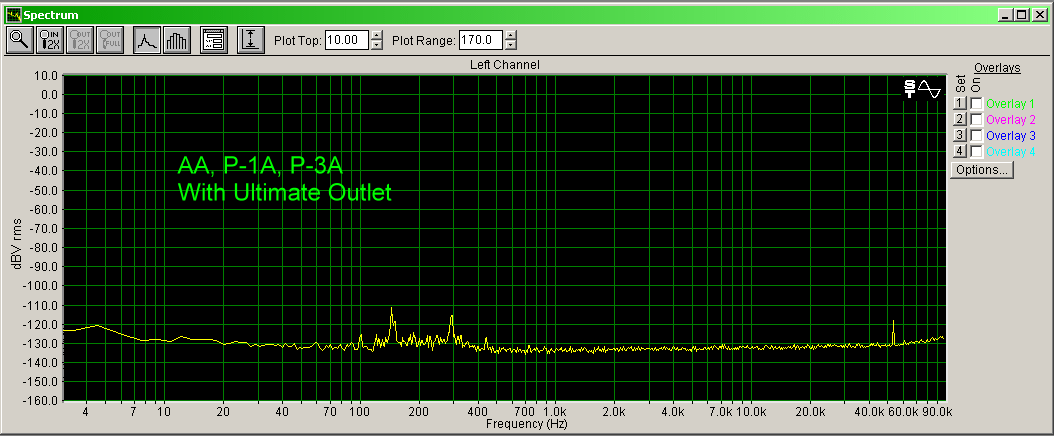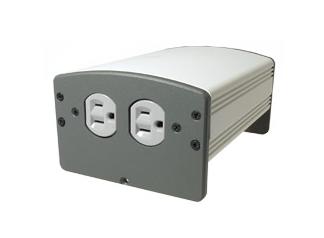Product Review - PS Audio
Ultimate Outlet - April, 2002
Jason Serinus
![]()
|
|
Specifications: Dimensions: 3
1/8" H x 5" W x 7" D |
|
PS Audio, 3050 Broadway, Suite 201, Boulder, Colorado 80304; Phone (Corporate Office) 877-772-8340; Fax 720-406-8967; E-Mail [email protected]; Web http://www.psaudio.com |
Introduction
If you have spent some time assembling an audio and/or home theater system,
you are undoubtedly familiar with the benefits of clean power. For those new
to the concept, suffice it to say that the AC power that comes out of
conventional wall outlets is often rife with noise. When that noise is
removed, a remarkable new audio clarity emerges. Once you have
heard the “blacker black” that
results from clean, steady AC, it is painful to regress to plugging everything
directly into the wall or a cheap surge protector.
Having previously waxed ecstatic about the multiple benefits of PS Audio's
P300 Power Plant and its MultiWave upgrade, I was much intrigued by the
arrival of their Ultimate Outlet. My interest was more than theoretical.
The Power Plant, which can reduce power line noise and distortion by up to 70
dB, does a marvelous job of regenerating quiet, clean, balanced AC in a manner
superior to most “power conditioners” on the market. The Power Plant corrects
low voltage, regulates power levels, repairs the typical clipped sine wave
that comes out of a home outlet, and converts wall voltage to balanced power.
Its indispensable MultiWave option allows the owner to adjust voltage,
frequency, and sine wave in a manner that greatly increases a recorded
performance's clarity, depth, frequency extension at both extremes, midrange
richness, and overall musicality. When digital gear is powered by the Power
Plant, much of the flat, harsh, two-dimensional limitations of conventional
digital reproduction vanish.
However, the Power Plant can only handle its rated wattage. A P300, for
example, outputs a bit over 300 watts of power, far less than the 1800 watts
typically available from an average wall socket. Nor is the P300 designed for
large power amplifiers; it can at best handle extremely low watt amps before
it reaches its power and heat capacity and blows a fuse. (You can add a fan to
its bottom, but that detracts from the quiet of your listening room.) Even my
P600, which can deliver up to 720 watts of power without overheating, exhibits
strain with my Class A, current-guzzling Bruce Moore Dual 70 tube power
amplifier. For this reason, I usually plug the amp directly into the wall.
Because the Power Plant is only 60% efficient, the P300 consumes maybe 30
watts at idle plus 160% of the rated wattage of all components plugged into
it. The P600 consumes 40-50 watts plus 160% of the wattage of all the
components plugged into it. Even if my 70-watt Bruce Moore amp only needed 300
watts of power to make it happy, it alone would consume 480 watts when plugged
into the Power Plant.
Enter the Ultimate Outlet, a low-cost solution for high current-consuming amps
such as mine, as well as for all home theater equipment, including equipment
that is not mounted on a conventional rack.
Uses, Specifications, and Benefits
The Ultimate Outlet is designed to operate like a wall socket. PS Audio claims
that the unit cleans power, lowering the noise floor by up to 40 dB, protects
from surges and lightning strikes, and lowers the output impedance of current
from the wall socket by a factor of three, thereby enhancing the audio performance of connected components. Furthermore, because the Ultimate
Outlet is bi-directional, PS Audio claims that it cleans the power emanating
from A/V components, preventing them from introducing additional noise into
the AC circuit. While the Ultimate Outlet cannot perform all of the power
regenerating and regulating functions of the considerably more expensive Power
Plant, it promises to go a long way toward improving the quality of one's
system.
In some of its literature, PS Audio states:
“Differential and common mode noise are the two basic forms of noise found on
home AC lines. Both are bad, and both are reduced significantly by the
Ultimate. Most other conditioners address one or the other type of noise, and
only above a certain frequency. No device other than the Ultimate Outlet can
handle both types of noise with no power restrictions.”
The Standard Ultimate Outlet is capable of handling 15-amps, or 3,600 watts.
The High-Current model is capable of 20 amps, or 4800 watts, of unrestricted
power, and offers consumers the choice of a 15- or 20-amp IEC connector. (In
actual use, Underwriters Laboratory standards set limits of 1875 watts for a
15-amp circuit and 2,500 watts for a 20-amp circuit).
The Standard 15-amp model is recommended for all video applications, including
small projectors and TVs, as well as small, medium and integrated amplifiers
and surround sound receivers. The 20-amp High-Current model is also suitable for
all these uses, but is specifically designed for big power amplifiers.

The unit comes with a removable, custom-made 14-gauge cable. PS Audio suggests
that replacing this with a multiple stranded, shielded cord of no more than
12-gauge will provide further benefits. The PS Audio Lab Cable is one possible
option.
It is not recommended that the Ultimate Outlet be installed inside a wall,
because
doing so makes it impossible to reach its fuse. Ultimate Outlets can be
mounted/placed on the floor, or on the wall using an optional quarter-inch
thick aluminum mounting plate ($29.95), or on the ceiling, or in the attic for
use with ceiling-mounted video projectors. They can either be plugged into the
wall - PS Audio recommends replacing standard wall outlets with their superior
Power Port - or into an output receptacle of a Power Plant. (You can only plug
them into the Power Plant if the equipment you plug into them doesn't exceed
the Power Plant's wattage limits.) Alternatively, PS Audio suggests that Power
Plants will produce quieter power if they are plugged into the Ultimate
Outlet.
How It Works
At the core of the Ultimate Outlet rests a balun, a donut of powdered iron
with a wire wrapped around each half of the donut. When an AC signal comes
into the balun's two wrappings of wire, the unit's balanced design cancels out
anything in common to the two wires. Because the balun boasts a small number
of wire turns, it purportedly cancels all noise at all frequencies without
restricting power.

To perform as effectively as possible, the Ultimate Outlet's balun is wrapped
with heavy-gauge, multi-strand Litz wire. Special attention is paid to
creating precision winding, which creates the input symmetry necessary for
optimal functioning.
Put to the Audio Test
I connected all my audio equipment, save for my Bruce Moore Dual 70 poweramp, to
my 600 Power Plant. The Power Plant was connected to one of the two PS Audio
Power Port wall sockets behind my equipment using a 6-foot length of Lab
Cable.
I then placed my High Current Ultimate Outlet (equipped with a 15-amp IEC) on
the floor behind my equipment, and connected it to the remaining wall socket
using a short run of PS Audio Lab Cable. Finally, I connected my Bruce Moore
Dual 70 poweramp into one socket of the Ultimate Outlet, using a Fatman Gold
2000 power cable on loan from the fabulous Cable Company. I compared what I
heard to the sound of the amp when the Ultimate Outlet was removed from the
chain and the Fatman Gold 2000 was plugged directly into a Power Port on a
different electrical circuit.
The Fatman Gold 2000 is one of the most expensive power cables on the market.
It's a fabulous cord, highly transparent, and capable of letting you hear far
more of your amp's potential than you would with most other power cables. One
would think/hope/pray that a cord costing so much would be so quiet that it
would not need an Ultimate Outlet to sound its best.
Think again. There was a marked difference in the sound of my amp when the
Fatman Gold 2000 was plugged into the Ultimate Outlet rather than into the
wall. Everything sounded quieter, clearer, and more transparent. Yet another
layer of grunge was removed, resulting in sound far more like the “real
thing.”
I switched the Fatman Gold 2000 amp cord back and forth many times between the
Ultimate Outlet and the Power Port wall outlet. One of my reasons for doing so
was to investigate initial criticism from some sources that the Standard
Ultimate Outlet sometimes dulled highs. I experienced no such dulling effect
with the High Current Ultimate Outlet. As far as I can tell, the High Current
Ultimate Outlet neither darkens the sound nor limits dynamics. Everything I
hear it do registers as positive.
I listened to any number of recordings, from my favorite Terry Evans “Blues No
More” track and Reference Recording's spectacular recent Respighi to Michael
Tilson Thomas' recent Ives disc (with baritone Thomas Hampson). I paid
attention to truth of timbre, soundstage width, microdynamics, bass extension,
clarity of highs, transparency, and overall musicality. In every case, my
listening experience deepened with the addition of the Ultimate Outlet to my
system.
Next, with the amp connected to one socket of the Ultimate Outlet, I plugged
my Power Plant into the remaining socket of the Ultimate Outlet. Damn, Paul
McGowan was right. As great as the Power Plant sounds by itself, it sounds
even better when plugged into the Ultimate Outlet!
When the amp and the Power Plant were both plugged into the Ultimate Outlet,
the bass became even tighter, with drums sounding more focused, and the top
became fuller. Thanks to an extra layer of transparency that heightened
colors, my listening experience moved significantly closer to what I hear in
live acoustic settings. Everything became more lifelike, more involving, more
“real” sounding. There was no mistaking the sonic improvements that the
Ultimate Outlet rendered to my system. (I defer any improvements that the
Ultimate Outlet might make to a video system in the hands of Stacey Spears at
some later date.)
Isolating Digital and Analog Gear
Digital gear may potentially produce noise that can be harmful to the sound
quality of analog gear. PS Audio therefore suggests that it may prove best to
isolate analog and digital gear from each other. Depending on the gear,
however, the improvement in sound quality achieved by isolating digital from
analog may be subtle at best. It seems that not all digital gear generates the
same amount of noise, and not all analog gear is equally susceptible to that
noise. From a practical standpoint, therefore, it's probably best to conduct
listening tests to see if isolation will really help before committing to
spend large amounts of money attaining it.
The Ultimate Outlet does not isolate one piece of equipment from another; the
Power Plant offers minimal isolation if analog and digital gear is plugged
into its different vertically paired outlets. Furthermore, while the Ultimate
Outlet does not generate noise of any kind, the Power Plant contains some
digital circuitry which, while generating little noise, does generate some.
The best way to isolate digital from analog gear when using the Power
Plant/Ultimate Outlet combination is to plug the digital gear into the
Ultimate Outlet, and then plug the Ultimate Outlet in the Power Plant. The
remaining analogue gear can then be plugged into the Power Plant. This will
give you 40 dB of isolation between the digital and analog gear.
If you have an analog amp, and the Power Plant cannot accommodate its wattage,
you may wish to purchase two Ultimate Outlets, one for the Power Plant, the
other for your amp. Only experimentation can determine what works best in your
situation.
In my setup, having only one Ultimate Outlet at my disposal, plus a tube
amp that puts a big strain on my P600, I chose to plug my P600 into one of the
Ultimate Outlet sockets, and my tube amp into the other. (As for my remaining
gear, my tube preamp is plugged into a different vertical socket than my other
digital gear. I rarely use my turntable, so noise in that circuit is not a
major concern.) Maybe I could achieve even more silence with two Ultimate
Outlets, one for the P600, the other for my amp. But, then again, it's not a
perfect world.
On the Bench (J. E. Johnson)
I connected an Audio Alchemy transport, along with a Perpetual Technologies P-1A and P-3A to the Ultimate Outlet, and collected spectra with the player on, with a CD in the transport, but not playing. The spectra were collected for 30 seconds in both cases, peak values retained. Here are the results. The first plot shows the base noise level without the Ultimate Outlet. The second plot shows the noise level with the Ultimate Outlet. It is clear that some low frequencies in the 300 Hz and 450 Hz area are reduced. There may be some increase in noise at the 100 Hz - 120 Hz region. Anytime you put something else in the electrical path, there has to be something introduced even if the purpose is to remove something else. I feel there is more removed here than introduced.


This is not a lot of noise reduction, but it is some, and I am satisfied that the Ultimate Outlet performs as advertised. Anything that can reduce noise is a worthwhile addition to the system, and the Ultimate Outlet is an inexpensive addition.
Conclusion
The Ultimate Outlet is a low-cost addition to an audio and/or home
theater setup. Its benefits extend even to those who possess costlier units
such as the Power Plant. The Ultimate Outlet's ease of positioning and
fool-proof operation, combined with its significant noise reduction capacity,
will move your home experience one major step closer to the real thing.
- Jason Serinus -
Review System:
Talon Khorus X speakers
Bruce Moore Dual 70 tube poweramp with Electro-Harmonix 6550 tubes,
Bruce Moore Companion III tube preamp with Siemens CCa tubes (rewired with
Nirvana hook-up wire)
Theta Gen. 5A single-ended DAC,
Perpetual Technologies P-1A with Monolithic Power Supply;
Audio Alchemy DDS-Pro transport
PS Audio P600 Power Plant power synthesizer with MultiWave;
PS Audio Ultimate Outlet;
PS Audio Power Ports in wall
Cabling:
Nordost SPM Reference speaker cable to the speakers,
Nordost single-ended Valhalla interconnect from Theta to preamp,
Nordost single-ended Quatro Fils interconnect from preamp to amp.
Nordost Silver Shadow AES/EBU digital interconnects from transport to P-1A and
P-1A to Theta,
Shunyata Python power cable on the transport, Nordost power cable on the
preamp; Custom Power Company Top Gun High Current power cable on the Theta,
Fatman Gold 2000 power cable on the amp, Ensemble power cable on the P-1A, and
the PS Audio Lab cable on the Power Plant and Ultimate Outlet
Sundry:
Michael Green Deluxe Ultrarack, Basic Racks, and room treatment; Black Diamond
Racing cones under Theta and preamp; MG audiopoints under other equipment;
inner tube, maple cutting boards, bags of sand also under transport; sand and
maple also under preamp, amp, and P600; homemade bass traps; Shakti stone atop
Theta and Shakti On-Lines on some power cables; Bedini Dual Beam
Ultraclarifier, Audioprism Stoplight and Blacklight, Gryphon Exorcist;
Sheffield/XLO degmagnetiser and break-in disc.
Analog (hardly the strong suit of the system, rarely used):
Dual 1219, Sumiko Blue Point and a Classe 6 phono preampwith the optional
umbilical cord. Paired with Tara Decade and Nirvana SL-1 interconnects, and a
Shunyata Black Mamba power cable.
![]()
© Copyright 2002 Secrets of Home Theater & High Fidelity
Return to Table of Contents for this Issue.


